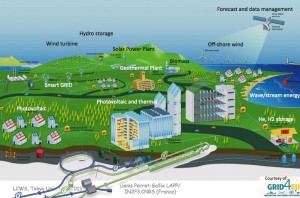When planning a new research lab, an important step is to see how others have done similar things in the past and learn from their experiences. The ILC, with its many contributors from research labs all over the world, has this step firmly embedded in its planning procedure. But planning a new research lab also means you’ve got a chance to do things differently. A small collaboration is starting to form that is looking at ways of making the ILC green from the very start.
The “green ILC” movement started two years ago at a workshop on energy for sustainable science at CERN, which covered all areas related to energy in research, from data servers and infrastructure to accelerators. Leading by example, the European Spallation Source ESS in Sweden, for which construction has just started, will be the world’s first sustainable research facility. Can the ILC follow suit?
The electricity consumption of the ILC will be everything but negligible. The ILC is certainly the less “energy hungry” of all future projects thanks, in particular, to its superconducting radiofrequency (RF) technology. However with 164 megawatts of peak power its consumption will be similar to CERN running the Large Hadron Collider, which in turn roughly equals the consumption of half of the 500,000 residents in the canton of Geneva. At the same time, the total beam power for the ILC’s e+e- collisions amounts to some 10 megawatts, leading to an overall efficiency of six percent – a lot of energy is lost in wasted heat from RF, powering the cooling plants or normal conducting magnets and in the beam dumps. “We increase the fundamental knowledge of mankind, but we waste a lot of energy doing that,” says Denis Perret-Gallix of IN2P3/CNRS, France. “I think we have a role to play in society, so let’s tackle the important aspect of the environment from the very beginning.” It might also mean substantial savings in the running costs.
The approach is to recycle and recover as much as possible of the energy that you can’t save in the first place. Klystrons, the accelerator’s pulse, currently operate at an efficiency of 60 percent in the best case; but “it might be possible to get them up to 80 percent if current R&D succeeds,” reports Hitoshi Hayano of KEK, Japan. This would mean a big dent in the power wasted in operations.
The beam energy in the beam dumps could be recovered and used not only to heat buildings or, more ingeniously, to cool equipment but, by vaporising liquid nitrogen, could produce electricity again.
But the prime interest in liquid nitrogen is that it can be used as a pre-cooling for the cryogenics, which could save a lot of power, even if safety and more complex operation issues should be addressed. “We could even produce it ourselves with the resources we have in Iwate – wind energy, geothermal energy, marine energy – and then retrieve this energy when needed,” suggests Takayuki Saeki from KEK.
Another possibility for the beam dumps currently being studied is to decelerate the beams through the formation of a wakefield in a gas plasma chamber. The microwaves produced by the exited plasma could then be recycled as electricity.
The group also proposes to build an energy centre on campus which would make sure the power is used well and innovations are put forward to society fast and efficiently by working hand in hand with power companies.
After the 2011 earthquake and tsunami and the Fukushima power plant accident, energy is a topic of concern in Japan, and the Japanese “Advanced Accelerator Association promoting science & technology” (AAA) decided to create a Green-ILC Working Group, which met in February this year. In fact sustainability is a topic that concerns all future colliders, from ILC and CLIC to the Chinese CepC-SppS project and the Future Circular Colliders discussed at CERN, so that during the recent LCWS14 workshop in Belgrade the future projects got together in a joint meeting to discuss sustainability options. The first starting point is a joint model of how energy is consumed in a collider so that projects can be compared accurately, which does not exist yet. “A greener ILC is just the first step towards sustainability” predicts Atsuto Suzuki, Director general of KEK. In order to make progress in fundamental science, projects need a lot of energy. But maybe in the long run this research can lead to progress in energy production and consumption as well.
The European Spallation Source ESS (europeanspallationsource.se) employs the “4R” strategy to make the facility as sustainable as possible. The four Rs stand for Responsible, Renewable, Recyclable and Reliable. Responsible refers to the power consumption, which will be monitored to stay below 270 GWh per year; renewable refers to the kinds of energy sources, which must all be renewable (for example wind energy) while being cost-competitive at the same time, and recyclable means that any surplus heat produced in the facility should be recycled, for example by replacing cooling towers with a cooling system that is based on heat recycling. Finally, all critical equipment like the cooling and power systems must be operated in a Reliable way to secure the facility’s operational availability for the researchers.


Recent Comments